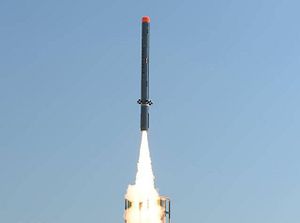India’s Defense Research and Development Organization (DRDO) successfully test-launched a nuclear-capable Nirbhay cruise missile, the country’s first indigenously designed and developed long-range cruise missile on November 7, the Indian Ministry of Defense (MoD) announced in a statement.
The test took place at the Integrated Test Range on Abdul Kalam Island off the coast of Odisha. “The flight test achieved all the mission objectives completely from lift-off till the final splash, boosting the confidence of all scientists associated with the trial,” the MoD said.
“The missile took off in the programmed manner and all critical operations viz. launch phase, booster deployment, engine start, wing deployment, and other operational parameters demonstrated through autonomous way point navigation,” the MoD added.
“The missile majestically cruised for a total time duration of 50 minutes, achieving the range of 647 km. The missile was tracked with the help of ground based radars and other parameters were monitored by indigenous telemetry stations developed by DRDO.”
The Nirbhay is a subsonic long-range land attack cruise missile that can be armed with a 300-kilogram warhead. The missile is capable of reaching speeds of 0.6-0.7 Mach and has an estimated strike range of around 1,000 kilometers. The Nirbhay, designed to be launched from air, sea, and land, reportedly is highly maneuverable and has loitering capabilities.
The recent test is good news for the Nirbhay program. The indigenous cruise missile project was kicked off in 2004 and projected to be completed by the end of 2016. However, the program has been plagued by many difficulties including technical problems with the missile’s flight control software and navigation system.
Since the inception of the program, DRDO engineers have repeatedly voiced their concern over the tight timeline of the project and lack of funding.
The last Nirbhay test launch in December 2016 ended in failure as the missile had to be destroyed in mid-air after it deviated from its course. “So far, only a flight trial of the missile conducted on October 17, 2014 met all test criteria. The missile reportedly traveled 1,010 kilometers while being monitored by the ground station and an Indian Air Force fighter jet,” I explained in December 2016.
As I noted:
Various analysts have questioned the Indian military’s requirement for a subsonic cruise missile given that the BrahMos supersonic cruise missile, capable of traveling at speeds of up to Mach 3.0 and available in surface-launched, ship-launched, and air-launched variants, is already entering service (See: “India to Test Fire Nuclear Capable Missile From Fighter Jet”).
The BrahMos has a much shorter maximum range than the Nirbhay. Nevertheless, there are still serious discussions with the Indian government about scrapping the latter program. In January, the Indian MoD agreed to let DRDO continue to work on the Nirbhay program until June 2018. Until then, substantial progress will have to be shown; otherwise the Nirbhay project will likely be axed next year.
As I noted last year, “the cancellation of the Nirbhay program would in particular be bad news for India’s first domestically developed and built ballistic missile nuclear submarine (SSBN) class, the Arihant-class, which was slated to be fitted with India’s domestically produced cruise missile.”






























